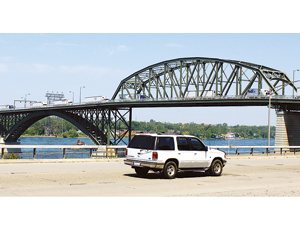In a bid to kick-start its own slowing economy and reverse growing unemployment, the Canadian government will spend $9.5 billion on road, bridge, public transit, water and other infrastructure over the next two years. The move is part of an overall $32-billion stimulus budget announced on Jan. 27.

Spending will include a $170-million rehabilitation of Canada’s busiest bridge, the steel-truss cantilever Champlain Bridge, in Montreal, and $11.7 million for two of the busiest U.S.-Canada crossings, including the Peace Bridge in Ontario. But allocation of project funds still awaits final details on provincial cost-sharing agreements not yet finalized.
More than 2,200 infrastructure projects could begin this spring if details are worked out, says Jean Perrault, Federation of Canadian Municipalities president and Sherbrooke, Quebec, mayor. The list of “shovel-ready” projects, derived from a survey of federation members, range from simple rehabilitation to major new construction on which environmental assessments, engineering and other planning have been completed or are not required, he says. Funding will also cover schools, Arctic research facilities and work on federal buildings, among other things.
While the new infrastructure funding will complement existing federal government spending, it also could leverage close to $7.2 billion in funding from other sources, primarily the provinces, says Jeff Morrison, president of the Association of Canadian Engineering Companies. There have been some engineering sector layoffs, but Morrison does not know of any major projects that have been scrapped. “It’s more a case of projects not going forward,” he says.
That situation is ongoing in the Alberta oil sands region, where oil price declines have led to major project deferrals, says Greg Stringham, vice president of markets and oil sands for the Canadian Association of Petroleum Producers, Calgary. The group estimates capital construction will plunge to $8 billion this year, compared to $16 billion in 2008.
With the budget focus on public infrastructure, federal spending won’t directly reverse the trend. But a $161-million program to improve business access to financing may loosen credit restrictions that also have led to deferrals, he says. Stalled oil-sands activity and a steep decline in Canadian homebuilding contributed to 44,000 construction-worker job losses in December. “We haven’t seen the figures for January yet,” says Michael Atkinson, president of the Canadian Construction Association.
Not everyone is happy that the spending will leave the federal government with a $68.5-billion deficit over a five-year period. “Eleven years of surpluses and debt reduction were wiped out in one big budget deficit binge” says Kevin Gaudiest, acting federal director of Ottawa-based Canadian Taxpayers Federation.

Post a comment to this article
Report Abusive Comment